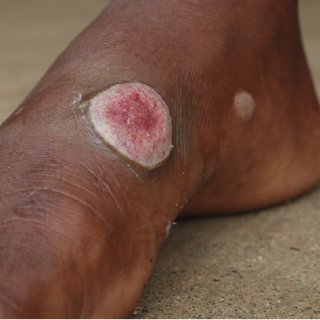Yaws

What is Yaws?
Yaws is a chronic infectious disease caused by the bacterium Treponema pallidum subspecies pertenue. It primarily affects the skin, bones, and joints. Yaws is endemic in certain tropical regions, particularly in rural areas of Africa, Asia, and the Pacific. The disease is transmitted through direct skin-to-skin contact with an infected individual, usually during childhood.
Who's at risk for Yaws?
Yaws mainly affects children living in impoverished communities with limited access to healthcare and basic sanitation. Factors that increase the risk of yaws include:
- Geographic location: Yaws is prevalent in tropical regions with poor hygiene, limited access to clean water, and overcrowded living conditions.
- Socioeconomic status: Individuals living in poverty, with inadequate sanitation, and limited healthcare resources are at higher risk.
- Age: Yaws primarily affects children between the ages of 2 and 15, although individuals of all ages can be affected.
What causes Yaws?
Yaws is caused by the bacterium Treponema pallidum subspecies pertenue, which enters the body through broken skin, usually during direct contact with an infected person. The bacteria multiply and spread through the lymphatic system, leading to the characteristic symptoms of the disease.
How does Yaws start?
Yaws usually starts with a painless sore or lesion known as a primary yaws lesion at the site of entry, often on the skin or mucous membranes. The primary lesion may go unnoticed or heal on its own within weeks or months. However, if left untreated, the infection progresses to secondary yaws, characterized by widespread skin lesions, bone and joint involvement, and potentially deformities.
What are the symptoms of Yaws?
The symptoms of yaws can vary depending on the stage of the disease. The primary and secondary stages are most commonly observed, while the tertiary stage is rare.
- Primary yaws: The initial symptom is a painless, raised, and crusted sore or lesion at the site of infection, typically on the skin or mucous membranes. The sore may spontaneously heal without treatment.
- Secondary yaws: Weeks to months after the primary sore appears, secondary yaws develops. It is characterized by multiple skin lesions, often on the face, extremities, or genitalia. These lesions are typically red, raised, and may be ulcerated. The skin lesions can be accompanied by fever, fatigue, and swollen lymph nodes.
- Tertiary yaws (rare): If left untreated, yaws can progress to a chronic stage known as tertiary yaws. This stage is characterized by destructive lesions that affect the skin, bones, and joints, leading to deformities, such as bone pain, disfigurement, and joint stiffness. Tertiary yaws can cause long-term disabilities.
How is Yaws diagnosed?
Diagnosing yaws involves a combination of clinical evaluation, medical history, and laboratory tests. A healthcare professional may:
- Conduct a physical examination: They will examine the skin and mucous membranes for characteristic yaws lesions and assess for any bone or joint abnormalities.
- Collect a blood sample: Blood tests, such as serological tests, can detect antibodies to Treponema pallidum subspecies pertenue and confirm the diagnosis.
- Take a skin sample: In some cases, a sample of fluid from a skin lesion may be collected and examined under a microscope to identify the presence of the bacteria.
How can Yaws be treated?
Yaws can be effectively treated with a single dose of oral antibiotics, typically penicillin or azithromycin. For individuals who are allergic to penicillin, alternative antibiotics may be prescribed. In addition to treating the infected individual, mass treatment campaigns may be implemented in endemic areas to control the spread of the disease.
What complications may occur with Yaws?
Without appropriate treatment, yaws can lead to long-term complications, particularly in the tertiary stage. These complications may include:
- Bone and joint deformities: Tertiary yaws can cause permanent damage to bones and joints, leading to joint stiffness, pain, and difficulty with movement.
- Disfigurement: Severe skin lesions and ulcerations in advanced stages of yaws can result in disfigurement, particularly on the face and extremities.
- Disability: Bone and joint deformities can result in physical disabilities that impact an individual's mobility and overall quality of life.
Prevention and early treatment are crucial in minimizing the risk of complications associated with yaws.
How can I prevent Yaws?
Preventing yaws involves a combination of public health measures and individual actions, including:
- Improved hygiene and sanitation: Access to clean water, proper sanitation facilities, and promoting good hygiene practices can help reduce the spread of yaws.
- Health education: Raising awareness about yaws, its transmission, and the importance of early treatment can help individuals recognize the symptoms and seek timely medical care.
- Treatment of affected individuals: Prompt identification and treatment of yaws cases, including contact tracing and treatment of close contacts, can help prevent further transmission.
- Mass treatment campaigns: In endemic areas, community-wide treatment campaigns may be conducted to treat affected individuals and reduce the reservoir of infection.
Long-term management of Yaws
After successful treatment, regular follow-up examinations may be necessary to monitor for any signs of disease recurrence. Additionally, efforts to improve living conditions, access to healthcare, and overall hygiene and sanitation are essential for long-term prevention and control of yaws.
Where can I go for more information on Yaws?
For more information on yaws, it is recommended to consult reputable sources such as the World Health Organization (WHO) or local health authorities. These organizations provide up-to-date information, guidelines, and resources on yaws, including prevention, treatment, and efforts to control the disease in endemic areas.

